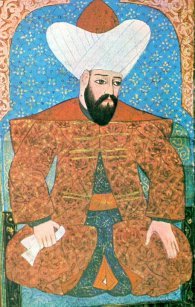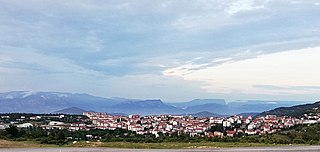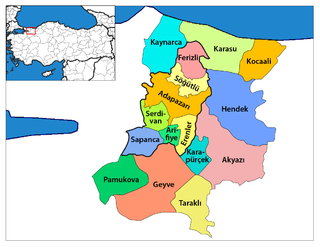
Osman I or Osman Ghazi was the founder of the Ottoman Empire. While initially a small Turkoman principality during Osman's lifetime, his beylik transformed into a vast empire in the centuries after his death. It existed until 1922 shortly after the end of World War I, when the sultanate was abolished.

Orhan Ghazi was the second sultan of the Ottoman Empire from 1323/4 to 1362. He was born in Söğüt, as the son of Osman I.

Söğüt is a town in Bilecik Province, Turkey. It is the seat of Söğüt District. Its population is 13,566 (2021). The mayor is İsmet Sever (MHP), elected in 2019.

Edirne, historically known as Adrianople, is a city in Turkey, in the northwestern part of the province of Edirne in Eastern Thrace. Situated 7 km (4.3 mi) from the Greek and 20 km (12 mi) from the Bulgarian borders, Edirne was the second capital city of the Ottoman Empire from 1369 to 1453, before Constantinople became its capital.

Çorum is a northern Anatolian city in Turkey. Çorum is located inland in the central Black Sea Region of Turkey and is approximately 244 km (152 mi) from Ankara and 608 km (378 mi) from Istanbul. It is the seat of Çorum Province and of Çorum District. Its population is 269,595 (2022). The city has an elevation of 801 m (2,628 ft) above sea level.

Bilecik Province is a province in midwest Turkey, neighboring Bursa to the west, Kocaeli and Sakarya to the north, Bolu to the east, Eskişehir to the southeast and Kütahya to the south. Its area is 4,179 km2, and its population is 228,673 (2022). Most of the province laid down in Marmara Region but eastern parts of Gölpazarı and Söğüt district and districts of İnhisar and Yenipazar remained in Black Sea Region, smaller southeastern parts of Bozüyük and Söğüt remained in Central Anatolia Region and smaller southwestern part of Bozüyük remained in Aegean Region.

Adıyaman is a city in southeastern Turkey. It is the administrative centre of Adıyaman Province and Adıyaman District. Its population is 267,131 (2021). The inhabitants of the city are mostly Kurdish.

Geyve is a municipality and district of Sakarya Province, Turkey. Its area is 662 km2, and its population is 50,799 (2022). The closest international airport is Istanbul Sabiha Gökçen International Airport, 139 km (86 mi) from Geyve. It is the largest district of Sakarya Province in terms of area. Geyve is located at the foot of Geyve Gorge, which is set between two mountain ranges and lies along the Sakarya River. Geyve region has an impressive green landscape and productive nature. Geyve is relatively close to many important cities in Turkey; 179 km (111 mi) to Istanbul, 30 km to Adapazarı, 75 km (47 mi) to Izmit, 139 km to Bursa, 156 km (97 mi) to Eskişehir, 167 km (104 mi) to Bolu by road.

Düzce is a city in northwestern Turkey, the capital city of Düzce Province, the eighty-first province in the country. It is the seat of Düzce District. Its population is 194,097.

Aydın is a city in and the seat of Aydın Province in Turkey's Aegean Region. The city is located at the heart of the lower valley of Büyük Menderes River at a commanding position for the region extending from the uplands of the valley down to the seacoast. The city forms the urban part of the Efeler district, with a population of 259,027 in 2022. Aydın city is located along a region which was famous for its fertility and productivity since ancient times. Figs remain the province's best-known crop, although other agricultural products are also grown intensively and the city has some light industry.

Ayvalık, formerly also known as Kydonies, is a municipality and district of Balıkesir Province, Turkey. Its area is 305 km2, and its population is 74,030 (2022). It is a seaside town on the northwestern Aegean coast of Turkey. The town centre is connected to Cunda Island by a causeway and is surrounded by the archipelago of Ayvalık Islands, which face the nearby Greek island of Lesbos.

Yalova is a market-gardening town located in northwestern Turkey on the eastern coast of the Sea of Marmara. It is the seat of Yalova Province and Yalova District. Its population is 133,109 (2022). A largely modern town, it is best known for the spa resort at nearby Termal, a popular summer retreat for residents of Istanbul.

Beyşehir is a municipality and district of Konya Province, Turkey. Its area is 2,054 km2, and its population is 77,690 (2022). The town is located on the southeastern shore of Lake Beyşehir and is marked to the west and the southwest by the steep lines and forests of the Taurus Mountains, while a fertile plain, an extension of the lake area, extends in the southeastern direction.
Pazaryeri, is a town in Bilecik Province in the Marmara region of Turkey. It is the seat of Pazaryeri District. Its population is 6,243 (2021). The district has several small lakes, as well as a number of buildings in traditional Ottoman style. The mayor is Zekiye Tekin. Pazaryeri is one of the most important hop producers in Turkey. The town has famous local dishes like helva and boza.

Sungurlu is a town in Çorum Province in the Black Sea Region of Turkey, located 72 km south-west of the city of Çorum. It is the seat of Sungurlu District. Its population is 30,275 (2022). The mayor is Muhsin Dere (MHP).

The Marmara Region is a geographical region of Turkey.
Paşalimanı Island, formerly Halone, is an island in the southern Sea of Marmara in Turkey. The island is the fifth largest island of Turkey and administratively belongs to the Erdek town of Balikesir Province in northwestern Turkey. The island has five small villages and has 962 population in total. Paşalimanı Island is also part of the Marmara Archipelago along with three other islands Marmara, Avşa and Ekinlik.

Yenişehir is a municipality and district of Bursa Province, Turkey. Its area is 720 km2, and its population is 54,844 (2022). It is 52 km far from the east of Bursa and Bursa city center. Bursa's international airport is within the borders of Yenişehir. For this reason, the airport is called 'Yenişehir Airport'.

The Osmangazi Tunnel, formerly Kocatepe Tunnel, is a road tunnel constructed on the Adapazarı–Bilecik state highway D.650 in Bilecik Province, western Turkey.

Qiniq also spelled Qïnïq, Qynyk or Qynyq, was an Oghuz Turkic tribe.


























